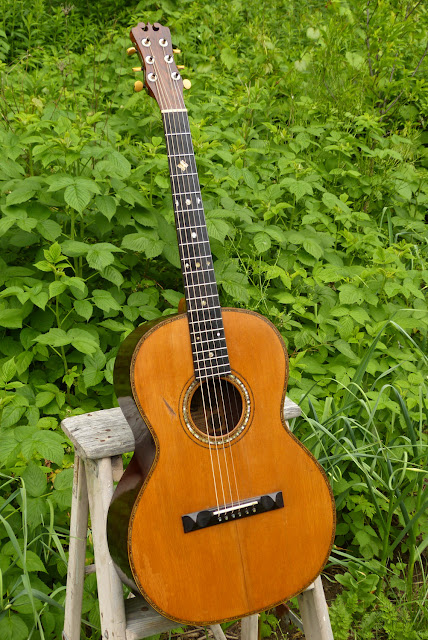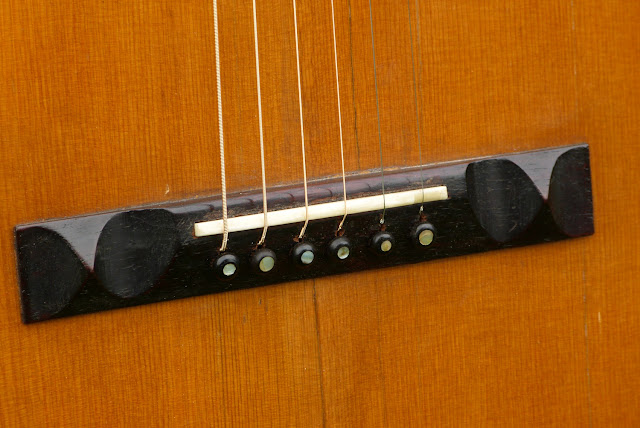1890s Joseph Bohmann 00-Size Flattop Guitar
Bohmann instruments are obscure and generally known only to folks who are in the know. I knew of them first from pictures of harp guitars around the net, but there are many of his more bizarre designs documented in various "guitar books" -- mostly because they're so strange. A writeup on Bohmann can be found here and a similar 1891 guitar can be found here.
What is superb about this guitar is that's it's not entirely strange, but it is of excellent quality and features a "quadruple x-bracing" that means its soundboard can both handle steel strings (rare for the time with a pin bridge) and also sounds amazing with them (rare for the time for anything intended for steel strings).
What does it sound like? Something like a cross between a late-20s/early-30s Martin 0-18, a Kel Kroydon, and an L-00. Like the Martin and the Kroydon, there's a very hi-fi and generously-warm low end to the guitar, but like the L-00, the mids are very punchy and focused. This is rare (at least to my ears) on x-braced flattops save Gibsons and I think it's mostly due to the fact that the bracing is light but also stiff. Here's what that bracing looks like:
As you can see, the majority of the bridge rests in a "diamond" area with the wings extending near the "middle" x-braces. I think they're actually slightly more in front of it, but my drawing is terrible.
Gibson attempted a "double x-bracing" similar to this in the '70s, but botched it by making the braces too stiff and the soundboard too thick. Some of them can sound great, but most are only so-so.
This guitar has the thin soundboard of a '20s Martin, but has bracing that's a little plainer and firmer, which is why I think the design works so successfully. The top is also flat under tension, which is something I never expect from a Martin or Gibson before the late '30s. That says to me that this guitar will remain far more stable over time as it's already lasted this long!
Also note that on the upper bout, Bohmann used three ladder braces. My own opinion is that there should just be a giant old block under that whole section (as it does little for acoustics), and apparently Mr. Bohmann was of more-or-less the same opinion -- make it stiff and strong to resist tension.
Well -- back to other details! This is 00-size with a 14 1/2" lower bout. It's a 12-fretter, has a 1 3/4" nut (with soft-V, slim-to-medium back profile), and has a 25" scale length. The top is solid spruce and the back and sides are solid Brazilian rosewood. The edges have "marquetry" purfling, the rosette has a bunch of pearl and abalone, and the fretboard inlay is pearl. Despite looking like ebony, the board (with a 12" radius) and bridge are ebonized Brazilian rosewood. The headstock veneer is also rosewood.
Work included a neck reset, fret level/dress, crack cleats/repairs, repair to a gash in the top near the soundhole (more on that, later), seam repairs, saddle-slot repair (just to square it up a bit better), and a new compensated bone saddle. It's strung with 48w, 36w, 26w, 18w, 14, 10 strings and the neck is straight (1/64" deflection overall), the action is spot-on (3/32" E, 1/16" ADGBE), and it's damn enjoyable! I have to admit that I was shocked at how good this guitar sounds. A few picker friends gave it a go this afternoon and they were blown away as well. This level of enthusiasm is usually reserved for late '20s/early '30s Martins, mind you. It works equally well flatpicked as it does fingerpicked -- which is a hard thing to do on a 12-fret.
I'm pretty sure this one was made in the late 1890s as the awards in the soundhole list up to 1895, yet the guitar itself is so similar to a couple on the net from the early/mid 1890s, and later labels have 1899 and 1900 award dates.
Everything on the guitar is original save one bridge pin (a replacement of similar period from my bins) and the new saddle. This nut is original and do you see the tuner "ferrules?" They're pearl!
The 12" radius on the board gives this guitar a much more modern feel than it looks like it should have.
The rosette is gorgeous, with contrasting pearl and abalone inlay. The "marquetry" inlay that's in full view everywhere is gorgeous as well -- and would've been a lot brighter when made -- bright yellows, reds, greens, and oranges.
Note the "gash" to the bass side of the hole. When this came in, it was punched in with splinters protruding from the back. Apparently it was a clamping job faux-pas! I put a patch/cleat on the rear, clamped it up, and then backfilled the remaining bit of muck and sealed it. Unfortunately, my color matching didn't work-out as intended and when I put the sealer-coat over it and buffed it up, the color turned a bit too dark. It's still better than a hole, though, and the original wood was all preserved.
The pyramid bridge is elegant, no? It's rosewood. The saddle slot is shallow and wide, so I got away with adding compensation to the guitar by profiling the top of the new saddle. Thankfully -- it plays right in tune up the neck. I had to do some fixing to the slot itself, however, as it was fairly uneven and didn't want to grab the saddle correctly -- it just needed truing-up.
Clearly, there's plenty of adjustment room on the saddle.
Brazilian! Brazilian! Pretty stuff...
Check out the mandolin-style enclosed tuners. They don't function beautifully, but once at pitch they hold well enough. They are super-classy, though. I had to replace a couple of screws up here.
The "volute" is nice, though, isn't it?
The neck seems to be Spanish cedar -- like on many nicer-grade instruments from the time.
For all the fancy trim on the top, the back is very plain and has no binding at all.

























Comments